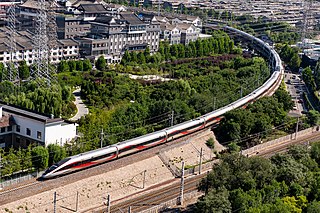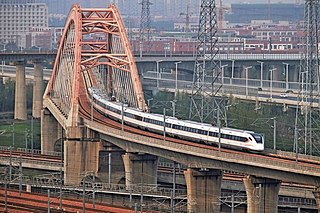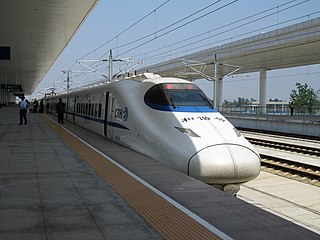
Passenger rail transport is one of the principal means of transport in the People's Republic of China, with rail passenger traffic exceeding 1.86 billion railway trips in 2011. It is operated by the China Railway Corporation (CR). The Spring Festival Travel Season is the peak railway travel season of the year.

The CRH2 Hexie is one of the high-speed train models in China. The CRH2 is based on the E2-1000 Series Shinkansen design from Japan with the license purchased from a consortium formed of Kawasaki Heavy Industries, Mitsubishi Electric, and Hitachi, and represents the second Shinkansen train model to be exported.

The high-speed rail (HSR) network in the People's Republic of China (PRC) is the world's longest and most extensively used – with a total length of 45,000 kilometres (28,000 mi) by the end of 2023. The HSR network encompasses newly built rail lines with a design speed of 200–380 km/h (120–240 mph). China's HSR accounts for two-thirds of the world's total high-speed railway networks. Almost all HSR trains, track and service are owned and operated by the China Railway Corporation under the brand China Railway High-speed (CRH).
China Railway High-speed (CRH) is a high-speed rail service operated by China Railway.

The CRH3 Hexie is a version of the Siemens Velaro high-speed train used in China on the Beijing–Tianjin intercity railway line, Wuhan-Guangzhou Passenger Dedicated Line, Zhengzhou-Xi'an Passenger Dedicated Line and the Shanghai–Nanjing intercity railway. It is capable of service speed of 380 km/h (236 mph) as the very similar Velaro E used in Spain, but, similarly to the Sapsan, it is 300 mm (11.8 in) wider to take advantage of a more generous structure gauge and thus be able to fit in more seats in a 2+3 layout.

Guangzhou–Zhuhai intercity railway or Guangzhu intercity railway is a dedicated, grade-separated regional railway linking Guangzhou South railway station in Panyu, Guangzhou, Jiangmen railway station in Xinhui, Jiangmen,and Zhuhai Jinwan Airport in Zhuhai, via Shunde, Zhongshan and Jiangmen, in Guangdong province. It is the first line completed in the Pearl River Delta Metropolitan Region intercity railway network. It is operated by China Railway Guangzhou Group.

The Hainan eastern ring high-speed railway is a high-speed railway on Hainan Island. It is operated by China Railway Guangzhou Group. Opened in December 2010, the railway links the capital Haikou at the northern end of the province, and goes alongside the eastern coastline to reach the resort city of Sanya in the southernmost region of the island. The railway share the end points with the Hainan western ring high-speed railway, which together creates a closed loop spanning 653 kms, as well as the world’s first circular high-speed railway, and allows passengers to travel around Hainan island in about 3 hours.

The CRH380A Hexie is a Chinese electric high-speed train that was developed by CSR Corporation Limited (CSR) and is currently manufactured by CRRC Qingdao Sifang. As a continuation of the CRH2-380 program it both replaces foreign (Japanese) technology in the CRH2 with Chinese developments and increases its top speed. The CRH380A is designed to operate at a cruise speed of 350 km/h (217 mph) and a maximum speed of 380 km/h (236 mph) in commercial service. The original 8-car train-set recorded a top speed of 416.6 km/h (258.9 mph) during a trial run. The longer 16-car train-set reached 486.1 km/h (302.0 mph).

China Railway comprehensive inspection trains, or CITs, are high-speed test trains used on the high-speed rail network of China and the Jakarta-Bandung High Speed Rail in Indonesia are normally owned and operated by China Railway or the China Academy of Railway Sciences (CARS) and Kereta Cepat Indonesia China.

The "fastest" train commercial service can be defined alternatively by a train's top speed or average trip speed.

The Pearl River Delta Metropolitan Region Intercity Railway System is a regional higher-speed rail and suburban rail network being gradually constructed in the Pearl River Delta, People's Republic of China. The project's goal is to have every major urban center in the Greater Bay Area to be within one-hour travel by rail to Guangzhou. On March 16, 2005, the State Council approved plans for a regional high-speed commuter rail network for the Jingjinji, Yangtze River Delta and the Pearl River Delta. According to the plan, by 2020, the network will have a total route mileage of about 600 kilometres (370 mi). In September 2009, the plan was expanded to 1,478 km (918 mi) of routes split up into 23 lines. In the long term vision network length will reach 1,890 km (1,170 mi) by 2030. By then the network will provide basic coverage to the Pearl River Delta region. The Suishen ICR, Guanhui ICR and Guangfozhao ICR accept Alipay, avoiding the need to purchase tickets in advance.

Zhengzhou–Kaifeng intercity railway, abbreviated as the Zhengkai intercity railway, is a higher-speed intercity railway in Henan, China, connecting Zhengzhou and Kaifeng. It is part of the larger Central Plain Metropolitan Intercity Rail network. Construction commenced on December 29, 2009. With a designed top speed of 160 km/h (99 mph), it is built as a double tracked electrified passenger dedicated line. Total length of this project is 50.33 kilometres (31.27 mi), costing an estimated 5.5 billion yuan to construct. Some trains through operate to Zhengzhou Xinzheng Airport via the Zhengji ICR or to Jiaozuo via the Zhengjiao ICR.

Changsha–Zhuzhou–Xiangtan intercity railway or Changzhutan intercity railway, is a higher-speed regional railway in Hunan, China. It connects the provincial capital Changsha with Zhuzhou and Xiangtan. The line was opened to traffic on 26 December 2016. A northwestern extension to Changsha West railway station opened on 26 December 2017. The maximum operating speed is expected to be up to 200 km/h (124 mph), travelling time between the three cities will be shortened to less than 30 minutes. The line uses China Railways CRH6F regional rail trains.

Fuxing is a series of high-speed and higher-speed EMU trains operated by China Railway High-speed (CRH) and developed by CRRC. They are the first successful high-speed trains to be fully designed and manufactured in China.

Hexie, also known as the CRH series EMU, is an umbrella term for the multiple unit high-speed and higher-speed trains operated by China Railway under the China Railway High-speed brand. All series of Hexie are based on foreign-developed technology and later manufactured locally in China through technology transfer licenses, with the ultimate goal of China acquiring the know-how and capability to produce high-speed rail trains.

Zhengzhou–Xinzheng Airport intercity railway is a regional higher-speed railway in Zhengzhou, Henan, China. The railway provides Zhengzhou city center fast train connections with Zhengzhou Xinzheng International Airport. It is a component of the larger Central Plain Metropolitan Intercity Rail network. With the opening of the railway, it takes only 19 mins from Zhengzhou East railway station to Xinzheng Airport.

The Zhengzhou–Shenzhen high-speed train (郑深高速动车组列车) are high-speed train services between Zhengzhou, the capital city of Henan Province, and Shenzhen, a major city in Guangdong Province.

The DJF2"Xianfeng" electric multiple unit is a model operated formerly by China Railway with traction motors distributed throughout the unit. It was developed in 2001 as a key task of the science and technology targets of the Ninth Five-Year Plan. It was an innovative and advanced design being the first Chinese multiple unit train to achieve 200 km/h (124 mph) and achieving a top test speed of 292.8 km/h (181.9 mph) in tests, but had numerous flaws in the design that complicated operations.
The KDZ1 is the first electrical multiple unit built in China. It is an experimental alternating current electrical multiple unit, developed by Changchun Railway Vehicles, CRRC Zhuzhou Institute and China Academy of Railway Sciences in 1978 and completed in 1988, though it never saw passenger service, with it being stored after it completed its initial tests.

The DJF1 "Zhongyuan Star" was an electric multiple unit of China Railway. It only operated in service for less than five years, before it was removed from service due to its various flaws and high maintenance costs. The train was initially built as a six car set, and subsequently lengthened to a fourteen car set. The two driving motors and the middle two motor cars have been preserved, with the other carriages being scrapped.






















